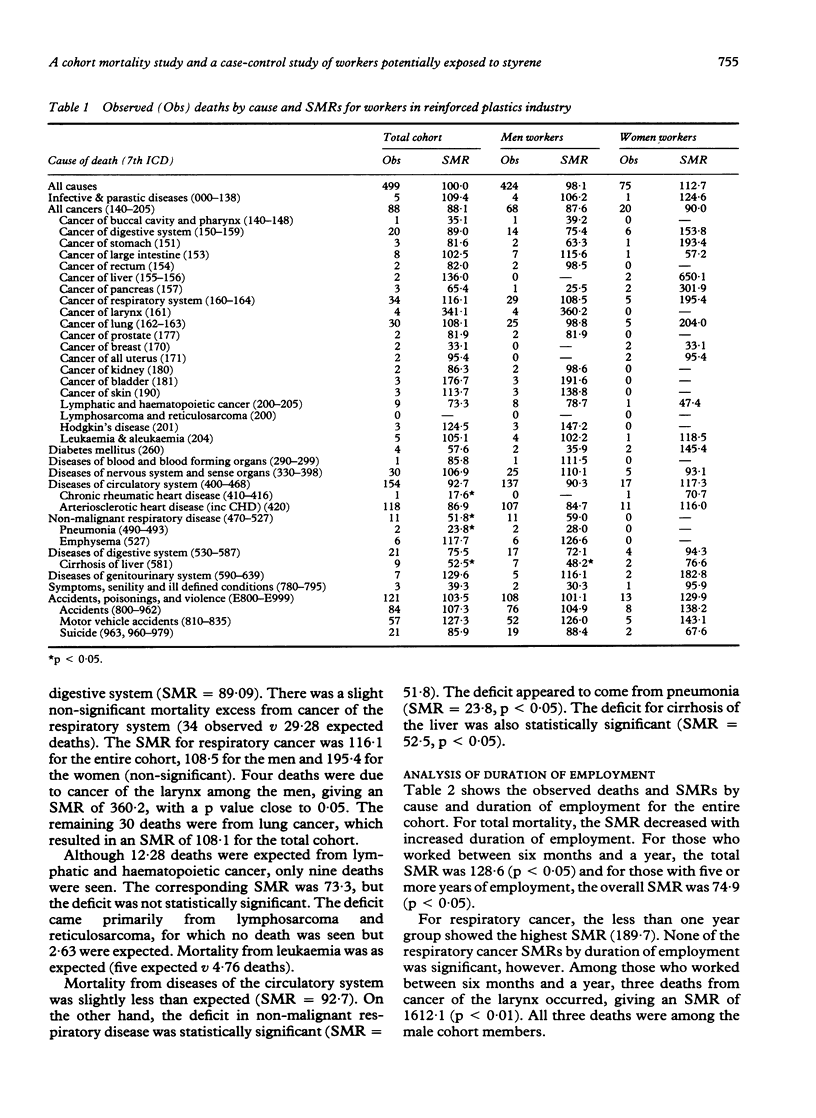Abstract
The cohort consisted of 15,908 men and women who worked for at least six months between 1948 and 1977 in 30 participating manufacturing plants in the reinforced plastics and composites industry. These workers were occupationally exposed to the working environment in the industry, which included exposure to styrene. Cause specific mortality analyses were performed based on the standardised mortality ratio (SMR) with the United States population as a comparison. No significant excess of cause specific mortality was found for the total cohort. Mortality from cancer was slightly less than expected (SMR = 88.1). For cancer of the respiratory system, a small non-significant excess was detected (SMR = 116.1). For lymphatic and haematopoietic cancer, a non-significant deficit was found (SMR = 73.3). The observed mortality from leukaemia was similar to that expected (five observed v 4.76 expected deaths). The plants with hot processes (injection moulding, centrifugal casting, compression moulding, continuous lamination, and pultrusion) experienced a significantly increased SMR (177.9) for respiratory cancer, which was more than twice that (78.3) for those with cold processes (resin mixing, lay up and spray up, bag moulding, and filament winding). As potential exposure to styrene from hot processes is considerably less than that from the cold processes, this finding could not be attributed to occupational exposures. A subsequent nested case-control study consisting of 40 cases of deaths from respiratory cancer was conducted. Further information on detailed work history, occupational exposures, and smoking history was collected. The case-control study did not show any significant association between respiratory cancer and direct exposure to styrene (contained in polyester resins), duration of exposure to styrene, the type of process (hot or cold), or whether a resin was used. A statistically significant association (relative risk = 7.33) was found between cigarette smoking and respiratory cancer among the study subjects.
Full text
PDF









Selected References
These references are in PubMed. This may not be the complete list of references from this article.
- Coggon D., Osmond C., Pannett B., Simmonds S., Winter P. D., Acheson E. D. Mortality of workers exposed to styrene in the manufacture of glass-reinforced plastics. Scand J Work Environ Health. 1987 Apr;13(2):94–99. doi: 10.5271/sjweh.2067. [DOI] [PubMed] [Google Scholar]
- Downs T. D., Crane M. M., Kim K. W. Mortality among workers at a butadiene facility. Am J Ind Med. 1987;12(3):311–329. doi: 10.1002/ajim.4700120307. [DOI] [PubMed] [Google Scholar]
- Fox A. J., Collier P. F. Low mortality rates in industrial cohort studies due to selection for work and survival in the industry. Br J Prev Soc Med. 1976 Dec;30(4):225–230. doi: 10.1136/jech.30.4.225. [DOI] [PMC free article] [PubMed] [Google Scholar]
- Frentzel-Beyme R., Thiess A. M., Wieland R. Survey of mortality among employees engaged in the manufacture of styrene and polystyrene at the BASF Ludwigshafen works. Scand J Work Environ Health. 1978;4 (Suppl 2):231–239. [PubMed] [Google Scholar]
- Hodgson J. T., Jones R. D. Mortality of styrene production, polymerization and processing workers at a site in northwest England. Scand J Work Environ Health. 1985 Oct;11(5):347–352. doi: 10.5271/sjweh.2214. [DOI] [PubMed] [Google Scholar]
- Johnson E. S. Treatment of subjects lost to follow-up in the analysis of mortality studies. J Occup Med. 1988 Jan;30(1):60–62. [PubMed] [Google Scholar]
- MANTEL N., HAENSZEL W. Statistical aspects of the analysis of data from retrospective studies of disease. J Natl Cancer Inst. 1959 Apr;22(4):719–748. [PubMed] [Google Scholar]
- Matanoski G. M., Schwartz L. Mortality of workers in styrene-butadiene polymer production. J Occup Med. 1987 Aug;29(8):675–680. [PubMed] [Google Scholar]
- Meinhardt T. J., Lemen R. A., Crandall M. S., Young R. J. Environmental epidemiologic investigation of the styrene-butadiene rubber industry. Mortality patterns with discussion of the hematopoietic and lymphatic malignancies. Scand J Work Environ Health. 1982 Dec;8(4):250–259. doi: 10.5271/sjweh.2469. [DOI] [PubMed] [Google Scholar]
- Nicholson W. J., Selikoff I. J., Seidman H. Mortality experience of styrene-polystyrene polymerization workers. Initial findings. Scand J Work Environ Health. 1978;4 (Suppl 2):247–252. [PubMed] [Google Scholar]
- Okun A. H., Beaumont J. J., Meinhardt T. J., Crandall M. S. Mortality patterns among styrene-exposed boatbuilders. Am J Ind Med. 1985;8(3):193–205. doi: 10.1002/ajim.4700080305. [DOI] [PubMed] [Google Scholar]
- Ott M. G., Kolesar R. C., Scharnweber H. C., Schneider E. J., Venable J. R. A mortality survey of employees engaged in the development or manufacture of styrene-based products. J Occup Med. 1980 Jul;22(7):445–460. [PubMed] [Google Scholar]
- Prentice R. Use of the logistic model in retrospective studies. Biometrics. 1976 Sep;32(3):599–606. [PubMed] [Google Scholar]


